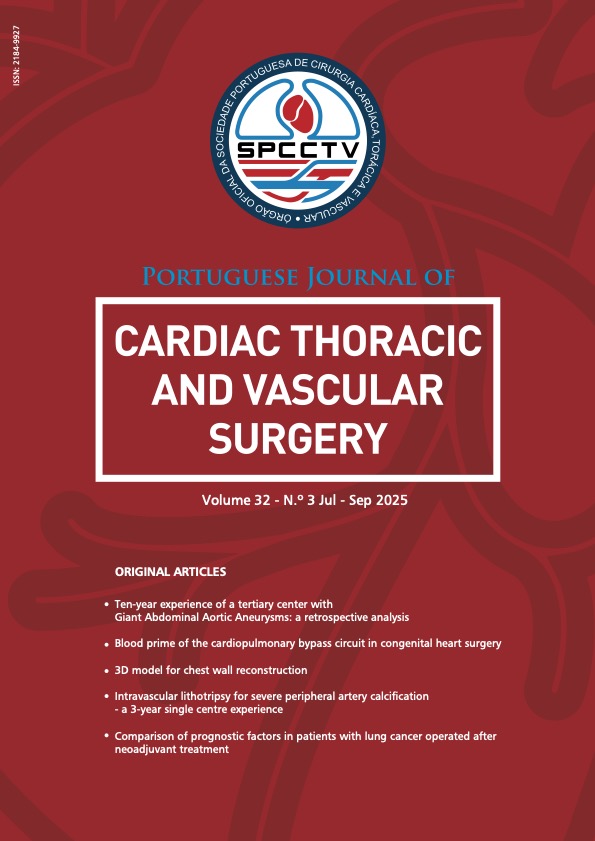3d Model For Chest Wall Reconstruction – Utility Survey
Utility survey
DOI:
https://doi.org/10.48729/pjctvs.521Keywords:
Chest wall, reconstruction, 3D, model, printedAbstract
Introduction: Three-dimensional (3D) models contributed to many improvements in surgical planning, presenting irrefutable advantages in many fields and may play a relevant role in chest wall surgeries. This study aims to evaluate their usefulness for chest wall reconstruction surgeries.Materials and Methods: All thoracic surgeons and residents practicing in the Iberian Peninsula and Latin America were asked to complete an online survey questionnaire, distributed through their respective national scientific societies. Results were analyzed using descriptive statistics and Mann–Whitney U test to access differences among surgeons with experience with 3D models and those without experience.
Results: A total of 145 answers were gathered from 15 countries. Most respondents had never performed thoracic wall reconstruction surgeries using rigid prosthesis with 3D patient-specific modeling. Most consensus was obtained regarding the positive contribution of a 3D model for preoperative communication with the patient, improvement in preoperative planning, and its positive role in training of less experienced surgeons. A tendency for neutral opinion was observed regarding its impact in avoidance of perioperative complications. Regarding 3D printing of a physical model, 74.8% agreed or strongly agreed that it is advantageous in comparison with a digital model, and 72.8% agreed or strongly agreed that it is advantageous for all candidates considered for chest wall reconstruction with rigid prothesis. Surgeons without experience with 3D models value significantly more than those with experience their contribution for a more precise preoperative planning (p=0.036), planning of surgery duration (p=0.008), and consider 3D printed models to be advantageous for all candidates to chest wall reconstruction surgery (p=0.028).
Conclusion: 3D patient-specific models are not accessible to most surgeons but the overall opinion on their usefulness is very positive. Printed models seem to be advantageous over digital ones, and beneficial for all patients undergoing chest wall reconstruction surgery.
Downloads
References
Xenofontos P, Zamani R, Akrami M. The application of 3D printing in preoperative planning for transcatheter aortic valve replacement: a systematic review. Vol. 21, BioMedical Engineering Online. BioMed Central Ltd; 2022.
Iobst CA. New Technologies in Pediatric Deformity Correction. Vol. 50, Orthopedic Clinics of North America. W.B. Saunders; 2019. p. 77–85.
Holt AM, Starosolski Z, Kan JH, Rosenfeld SB. Rapid Prototyping 3D Model in Treatment of Pediatric Hip Dysplasia: A Case Report. Iowa Orthop J . 2017;37:157–62.
Cherkassky L, Caffrey JP, Szewczyk AF, Cory E, Bornar JD, Farnsworth CL, et al. Patient-specific 3D models aid planning for triplane proximal femoral osteotomy in slipped capital femoral epiphysis. J Child Orthop. 2017;11(2 Special Issue):147–53.
Wei YP, Lai YC, Chang WN. Anatomic three-dimensional model-assisted surgical planning for treatment of pediatric hip dislocation due to osteomyelitis. Journal of International Medical Research. 2019;48(2).
Facco G, Palmisani R, Pieralisi M, Forcellese A, Martiniani M, Specchia N, et al. Case series of four complex spinal deformities: new frontiers in pre-operative planning. Acta Biomedica. 2022;93(5).
Galkwad A, Malhotra R, Bikash Maiti S, Shetty AA, Rasheed DS, Kashyap L, et al. Role of 3D Printing in Post-op Rehabilitation of Palatal Bone Loss by Mucomycosis: A Survey. Cureus. 2022 Dec 14;
Yoo SJ, Spray T, Austin EH, Yun TJ, van Arsdell GS. Hands-on surgical training of congenital heart surgery using 3-dimensional print models. Journal of Thoracic and Cardiovascular Surgery. 2017 Jun 1;153(6):1530–40.
Karsenty C, Guitarne A, Dulac Y, Briot J, Hascoet S, Vincent R, et al. The usefulness of 3D printed heart models for medical student education in congenital heart disease. BMC Med Educ. 2021 Dec 1;21(1).
Su W, Xiao Y, He S, Huang P, Deng X. Three-dimensional printing models in congenital heart disease education for medical students: A controlled comparative study. BMC Med Educ. 2018 Aug 2;18(1).
Traynor G, Shearn AI, Milano EG, Ordonez MV, Velasco Forte MN, Caputo M, et al. The use of 3D-printed models in patient communication: a scoping review. J 3D Print Med. 2022 Mar;6(1):13–23.
Tsuge I, Saito S, Sakamoto A, Matsuda S. Anterior chest wall reconstruction after resection of a sternal tumor with a single mandibular plate and Gore-Tex® sheet. Vol. 44, Asian Journal of Surgery. Elsevier (Singapore) Pte Ltd; 2021. p. 563–5.
Simal I, Garcia-Casillas M, Cerda J, Riquelme O, Lorca-García C, Pérez-Egido L, et al. Three-Dimensional Custom-Made Titanium Ribs for Reconstruction of a Large Chest Wall Defect. European J Pediatr Surg Rep. 2016 Dec;04(01):026–30.
Illmann CF, Hosking M, Harris KC. Utility and Access to 3-Dimensional Printing in the Context of Congenital Heart Disease: An International Physician Survey Study. CJC Open. 2020 Jul 1;2(4):207–13.
Byrne N, Velasco Forte M, Tandon A, Valverde I, Hussain T. A systematic review of image segmentation methodology, used in the additive manufacture of patient-specific 3D printed models of the cardiovascular system. JRSM Cardiovasc Dis. 2016 Jan 1;5:204800401664546.
Valverde I. Impression tridimensional de modelos cardíacos: aplicaciones en el campo de la educación médica, la cirugía cardiaca y el intervencionismo estructural. Vol. 70, Revista Espanola de Cardiología. Ediciones Doyma, S.L.; 2017. p. 282–91.
van de Belt TH, Nijmeijer H, Grim D, Engelen LUPG, Vreeken R, van Gelder MMHL, et al. Patient-Specific Actual-Size Three-Dimensional Printed Models for Patient Education in Glioma Treatment: First Experiences. World Neurosurg. 2018 Sep 1;117:e99–105.
Biglino, G., Capelli, C., Leaver, L.-K., Schievano, S., Taylor, A. M., & Wray, J. (2016). Involving patients, families and medical stal in the evaluation of 3D printing models of congenital heart disease. Communication and Medicine, 12(2-3), 157–169. https://doi.org/10.1558/cam.28455
Downloads
Published
How to Cite
License
Copyright (c) 2025 Portuguese Journal of Cardiac Thoracic and Vascular Surgery

This work is licensed under a Creative Commons Attribution 4.0 International License.





